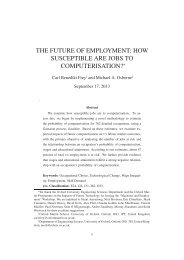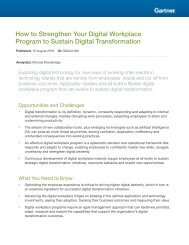THE FUTURE OF EMPLOYMENT: HOW SUSCEPTIBLE ARE JOBS TO COMPUTERIZATION?
We examine how susceptible jobs are to computerization. To assess this, we begin by implementing a novel methodology to estimate the probability of computerization for 702 detailed occupations, using a Gaussian process classifier. Based on these estimates, we examine expected impacts of future computerization on US labor market outcomes, with the primary objective of analyzing the number of jobs at risk and the relationship between an occupation’s probability of computerization, wages and educational attainment. According to our estimates, about 47 percent of total US employment is at risk. We further provide evidence that wages and educational attainment exhibit a strong negative relationship with an occupation’s probability of computerization.
We examine how susceptible jobs are to computerization. To assess this, we begin by implementing a novel methodology to estimate the probability of computerization for 702 detailed occupations, using a Gaussian process classifier. Based on these estimates, we examine expected impacts of future computerization on US labor market outcomes, with the primary objective of analyzing the number of jobs at risk and the relationship between an occupation’s probability of computerization, wages and educational attainment. According to our estimates, about 47 percent of total US employment is at risk. We further provide evidence that wages and educational attainment exhibit a strong negative relationship with an occupation’s probability of computerization.
You also want an ePaper? Increase the reach of your titles
YUMPU automatically turns print PDFs into web optimized ePapers that Google loves.
obots can now reproduce some aspects of human social interaction, the realtime<br />
recognition of natural human emotion remains a challenging problem, and<br />
the ability to respond intelligently to such inputs is even more difficult. Even<br />
simplified versions of typical social tasks prove difficult for computers, as is<br />
the case in which social interaction is reduced to pure text. The social intelligence<br />
of algorithms is partly captured by the Turing test, examining the ability<br />
of a machine to communicate indistinguishably from an actual human. Since<br />
1990, the Loebner Prize, an annual Turing test competition, awards prizes to<br />
textual chat programmes that are considered to be the most human-like. In<br />
each competition, a human judge simultaneously holds computer-based textual<br />
interactions with both an algorithm and a human. Based on the responses, the<br />
judge is to distinguish between the two. Sophisticated algorithms have so far<br />
failed to convince judges about their human resemblance. This is largely because<br />
there is much ‘common sense’ information possessed by humans, which<br />
is difficult to articulate, that would need to be provided to algorithms if they are<br />
to function in human social settings.<br />
Whole brain emulation, the scanning, mapping and digitalising of a human<br />
brain, is one possible approach to achieving this, but is currently only a<br />
theoretical technology. For brain emulation to become operational, additional<br />
functional understanding is required to recognise what data is relevant, as well<br />
as a roadmap of technologies needed to implement it. While such roadmaps exist,<br />
present implementation estimates, under certain assumptions, suggest that<br />
whole brain emulation is unlikely to become operational within the next decade<br />
or two (Sandberg and Bostrom, 2008). When or if they do, however, the employment<br />
impact is likely to be vast (Hanson, 2001).<br />
Hence, in short, while sophisticated algorithms and developments in MR,<br />
building upon with big data, now allow many non-routine tasks to be automated,<br />
occupa tions that involve complex perception and manipulation tasks,<br />
creative intelligence tasks, and social intelligence tasks are unlikely to be substituted<br />
by computer capital over the next decade or two. The probability of an<br />
occupation being automated can thus be described as a function of these task<br />
characteristics. As suggested by Figure I, the low degree of social intelligence<br />
required by a dishwasher makes this occupation more susceptible to computerisation<br />
than a public relation specialist, for example. We proceed to examining<br />
the susceptibility of jobs to computerisation as a function of the above described<br />
27





